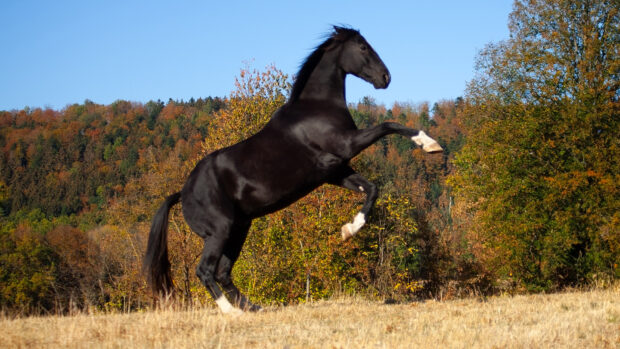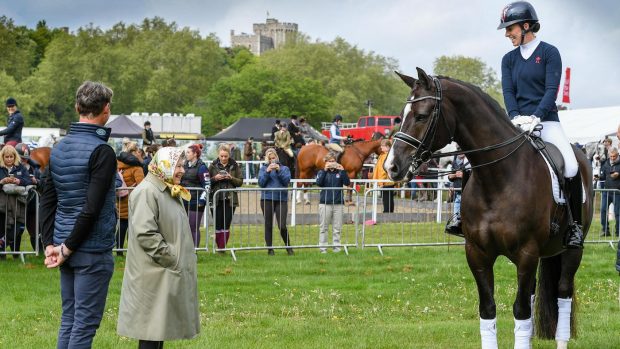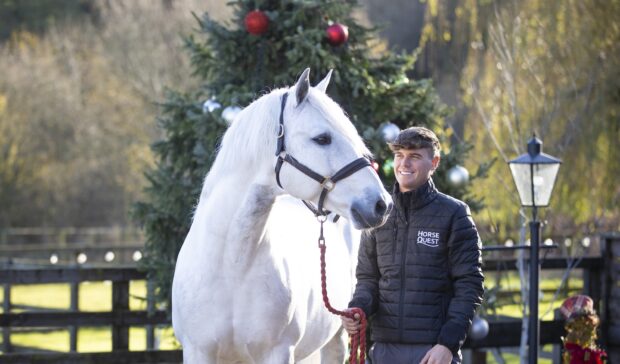Emotions in horses can be difficult to read. Horses don’t smile in the same way as humans and they can’t tell us if they are sad, miserable or in pain. So as riders and horsemen (and women), we have to learn how to figure out horses’ feelings.
“Obviously we’ve all been brought up to try not to anthropomorphise too much – we don’t want to infer emotions on horses that they’re maybe not capable of experiencing,” says Dr Gemma Pearson, a qualified equine veterinary behaviourist who is director of equine behaviour for The Horse Trust. “I still see an awful lot of that – riders and trainers talking about the horse doing this because of that and actually you think that really is anthropomorphism. That’s not a route we really want to go down.
“But at the same time, there are things we do understand about emotions in horses.”
Gemma splits this knowledge into two different areas.
“First of all we talk about the horse’s level of arousal – that’s almost like the horse’s level of alertness. We can have horses which have a low level of arousal, which are very relaxed, and then we can have horses that have a very high level of arousal,” she explains.
The second area is the “affective state” of the horse.
She says: “This is basically whether the horse is happy or sad. How do we know if a horse is happy? To be honest we never will, but we shouldn’t let perfect be the enemy of good. Just because we can’t measure something perfectly, it doesn’t mean we can’t have a good idea from other work that we’ve done. I’m sure we all know the difference between a horse that’s eating its feed or grazing with its friend and it’s very happy, compared to a horse that’s very stressed.”
A happy horse with a high level of arousal would be experiencing what we might describe as excitement.
“We often talk about a happy horse with a low level of arousal being relaxed and that’s great, but if you’re taking a horse around a cross-country course, you don’t want them to be too relaxed – you’ve got to have some adrenaline flowing and the horse’s level of arousal has to be pretty high. That keeps them sharp,” says Gemma.
“The other side of the coin is where we have a negative affective state so unhappy horses. Again, we can have that with a high level of arousal so that’s horses that we might describe as stressed, or with a low level of arousal so that’s where we might start to think about things like depression in horses or learned helplessness, where a horse looks really dull in its eye and they’re not reacting to very much in the environment.”
Emotions in horses: arousal levels
Gemma says a lot of the time when she sees people having problems working with horses, it’s because the horse’s level of arousal is too high for what the person is trying to achieve.
“When the horse’s level of arousal is too high, they can’t learn any more,” she says.
Gemma says this is the same in people – there’s an optimum level of stress or arousal for learning or performance. If the level is too low, you’re too relaxed and don’t perform well, but once it gets too high you can’t perform well either.
“Most of the time when I see problems with horses it’s because their arousal level is really high and we need to break it down, make whatever exercise we’re doing easier for the horse and help them to stay calmer.”
How can you check a horse’s arousal level?
“Obviously we can look for the normal behavioural indicators that the horse is hypervigilant – its ears and eyes are focused on everything in the environment but not necessarily the rider or the handler, and the horse may have a lot of muscular tension,” she says.
“Look at the eye, look at the ears, look at the muzzle. The muzzle may become longer so the corner of the lip gets drawn back, the chin may become more prominent. Look for generalised muscular tension in the horse and that will give you a really good indicator whether their level of arousal is acceptable or not.
“If you’re riding them you’ll feel it in the way they move – rather than being nice and loose and relaxed, the steps just become that little bit more jerky and tense.”
Gemma says that being able to recognise these different states in horses is really important for optimising training.
Coping styles: active and reactive
We also need to remember that horses have different coping styles.
Gemma explains: “When we talk about horses with a high level of arousal, with a negative affective state, so a stressed or tense horse, people automatically think of the fight or flight response.
“This is what we call an active coping mechanism – the horse sees something they are fearful of and they try and run away from it. For example, the horse is fearful of clippers, someone’s holding on to them, the horse barges them out the way. And if that’s not going to work, if the horse feels it’s their only option they may resort to kicking or biting or striking out at people.”
Gemma adds fidget to fight and flight as active coping mechanisms.
“This is with a slightly lower level of arousal – when you have a horse that’s fairly relaxed and you go to do something with them, maybe think about clipping them, and all of a sudden they have to rub their head on you or they have to sniff the floor or they have to start itching their side. These horses are actually showing they’re not very confident with what we’re doing at that point in time, so they’re starting to fidget.”
Then there are horses which are “reactive copers”.
“This is where horses can freeze and I think this is something people miss a lot in horses. They’ll often say the horse was stood still and then they suddenly exploded. These animals will freeze, stand there and do nothing, until they get to a certain threshold and then that’s when they may explode – a little like a rabbit might freeze in the headlights or when someone’s approaching it, until the person gets too far, too close to them and then they may suddenly shoot off.”
Gemma frequently sees horses freezing when they are being loaded onto the trailer or lorry and they plant on the ramp, leading handlers to believe the horse is being stubborn.
“But when you actually look at these horses, they’re not calm and relaxed and enjoying life – they’re actually really tense. They’ve gone into this freeze response where they just try to switch off to all the cues and that may be people shouting at the horse, hitting the horse, pulling on the headcollar. That’s their coping mechanism until it gets to a certain level and then the horse may shoot backwards or try and jump off the side.”
You might also be interested in:
The aim of the video series is to improve welfare and performance in ridden horses

Why a pat on the neck isn’t what your horse would choose and how to use rewards effectively in training

Is your horse in pain? New videos explain the key signs

The Horse & Hound Podcast 127: Yasmin Ingham | Pau five-star review | Emotion in horses | News round-up

Education on how horses learn may help keep vets safe

Subscribe to Horse & Hound magazine today – and enjoy unlimited website access all year round
Horse & Hound magazine, out every Thursday, is packed with all the latest news and reports, as well as interviews, specials, nostalgia, vet and training advice. Find how you can enjoy the magazine delivered to your door every week, plus options to upgrade your subscription to access our online service that brings you breaking news and reports as well as other benefits.




